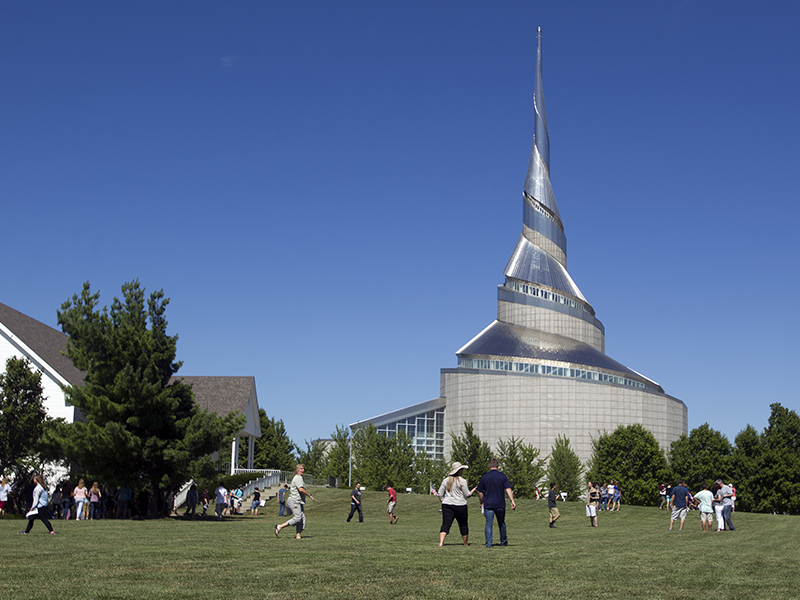INDEPENDENCE, Mo. (RNS) — There is an open patch of grass at the intersection of River Boulevard and Walnut Street in this Kansas City suburb. It looks like a vacant lot — no structures, no landscaping, no fence.
But this 2.5-acre site is sacred to a number of religious groups, all of which trace their origins to Joseph Smith Jr., the Mormon prophet. It is here, Smith declared in 1831, that Jesus will return — and soon — to rule his kingdom from a beautiful temple.
For now, there is no temple — construction never got past the laying of cornerstones. But the three largest Mormon denominations have presences in and around Temple Lot: The 15 million-member Church of Jesus Christ of Latter-day Saints runs a visitors center on one corner across the street; the Community of Christ, with 200,000 members, has its world headquarters and an auditorium on two other corners; and the Church of Christ (Temple Lot), which has just 5,000 members, has a low-slung sanctuary a few steps away.
The world has no shortage of contested religious sites. From the Temple Mount and Church of the Holy Sepulchre in Jerusalem to the former Babri Mosque built on the site of an ancient Hindu temple in Ayodhya, India, different faiths have both tried to share — and waged bloody conflicts over — spaces considered sacred to their traditions.
Here in the U.S., the three Mormon denominations present at Temple Lot have found a way to peacefully share the contested space, as well as two other sites nearby.
The roots of their disputes may not be as deep as the ones that entangle contested sites overseas. But they are certainly complex and emotional, and the Mormon factions’ efforts to come to terms with their conflicting claims has only come about through gestures of magnanimity and evolved thinking on the part of believers who follow the same founding prophet.
[ad number=“1”]
“You know the old saying, ‘There’s no fight like a family fight?'” said Steven L. Olsen, senior curator for historic sites for the LDS church and a seventh-generation Mormon. “I think we have gotten over that because we realize there are bigger issues than the sectarian issues that divided us. We can accomplish a lot more together than we can by fighting each other.”
Shared history
Since Mormonism was born in America and splintered into dozens of religious groups, it may not be surprising that some of the places that figure in the Latter-day Saints’ founding stories are subject to competing claims.
Current estimates range between 30 and 100 active denominations that trace their lineage to Smith’s revelations, recorded in The Book of Mormon in 1830.
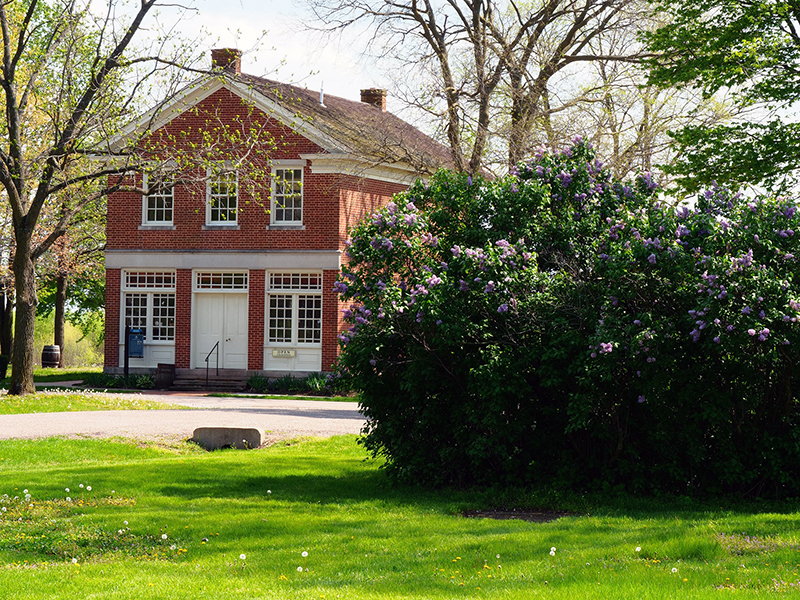
Joseph Smith’s Red Brick Store in Nauvoo, Ill., on April 18, 2017. Photo by Dennis Piepergerdes
Yet today, the three largest of these may have more theological differences than commonalities. The LDS church and the Church of Christ (Temple Lot) retain their belief in a literal and imminent return of Jesus to Independence, while the Community of Christ does not.
The LDS church has “temple ordinances” — sacraments and rites performed in temples for baptism of the dead, marriage and “sealing” families as “eternal.” Neither of the other two has these ordinances.
And only Community of Christ ordains women and accepts noncelibate LGBT people as full members.
Though Smith’s “Latter-day Saint movement” is 187 years old, only 14 years of that is shared.
“For 14 years, there was a common tree trunk,” said Lachlan Mackay, a Community of Christ historian. “Then the splintering happened.”
And with it came the contested sacred places.
Kirtland Temple
One of them is the Kirtland Temple, near Cleveland, the first temple Smith established.
The white, steepled structure wouldn’t be out of place in New England.
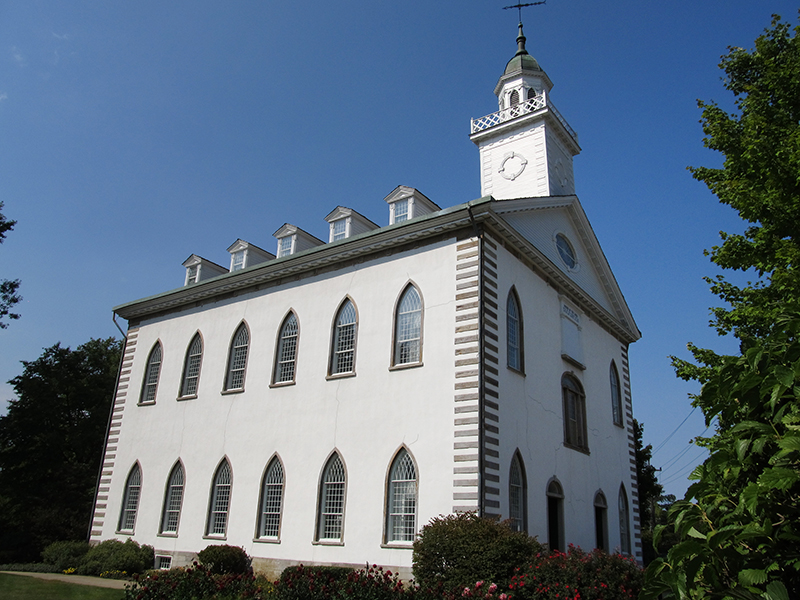
The Kirtland Temple near Cleveland is owned by the Community of Christ. Photo courtesy of Creative Commons/Ken Lund
In April 1836, Smith claimed he saw Jesus standing at one of its two pulpits. Smith believed Jesus was accepting and blessing the temple and his followers. In other visions at Kirtland Temple, Smith claimed “heavenly visitors” gave him the “keys” — the authority — to conduct temple ordinances.
For LDS church members, this event is sacred scripture, incorporated in their Doctrine and Covenants in 1876. They believe Jesus literally stood at the pulpit of the Kirtland Temple.
But in Community of Christ terminology, Smith’s visions were more spiritual experiences than actual events — they do not teach Jesus literally stood in the Kirtland pulpit. They hold only one of Smith’s several visions — his first, in a New York forest in 1820 — as important because, they believe, it shows the healing of God and the mercy of Jesus.
And it is the Community that owns Kirtland Temple.
[ad number=“2”]
David Howlett, a Community of Christ historian and author of “Kirtland Temple: The Biography of a Shared Mormon Sacred Space,” said relations there have always been cordial, if sometimes strained. During tours in the 1960s and 1970s, members of the two denominations would sometimes confront each other on the priesthood, plural marriage and more.
“I know from talking with guides from the 1970s, they were ready to go to war,” he said. “They knew what to hit their LDS guests with and they were ready to tangle.”
But the last 20 or so years have seen a change.
Community of Christ allows its “Mormon cousins” to hold worship, prayer and meetings in the temple’s sanctuary. Together, they hold joint Thanksgiving and Easter services and the annual Emma Smith Hymn Festival, named for Smith’s widow. The LDS church has funded a roof replacement and some structural studies as well.

Steven Olsen of The Church of Jesus Christ of Latter-day Saints history department. Photo courtesy of The Church of Jesus Christ of Latter-day Saints
The LDS perspective of events is included in the tour guides’ script, and they always point out the pulpit where Smith said he saw Jesus stand.
Olsen, the LDS historian, recalls when, in 2003, then-church President Gordon Hinckley was given a tour of Kirtland Temple. The elderly Hinckley asked for a few minutes alone in the sanctuary. It was against the rules, but …
“They ushered everyone out and President Hinckley got to spend an hour in the temple contemplating what we call the ‘solemnities of eternity’ that transpired there,” he said. “That was an amazing act of generosity.”
Howlett says it is not so much that everyone gets along as that what they disagree on has changed.
“For Community of Christ, it doesn’t matter whether this or that really happened at Kirtland,” he said. “It is more about the community Kirtland represents. That makes cooperation easier for them both.”
Nauvoo
There is an old joke among Community of Christ members that their historical sites exist to ruin LDS family vacations.
That’s no longer true in Nauvoo, Ill., the small pioneer town Smith and his thousands of followers founded along a bend in the Mississippi River.

Competing billboards for LDS, top, and Community of Christ, bottom, are removed in Nauvoo, Ill., in April 2013. Photos by Lachlan Mackay
Here, the two churches share the log, clapboard and brick buildings. Community of Christ owns the Smith-related sites while the LDS church owns sites associated with Brigham Young and other early church leaders. Visitors cross denominational lines without even knowing it.
But there once was a kind of border crossing — two billboards facing opposite directions had the effect of announcing “You are now entering” each church’s territory.
The billboards came down five years ago after a discussion over chips and salsa at a local Mexican restaurant.
“Steve Olsen (the LDS historian) was there and I was there and one of us said, ‘Hey, if we take ours down will you take yours down?'” said Mackay, the Community of Christ historian and overseer of the church’s Nauvoo sites. “It was silly, in the middle of historical sites, to have these billboards.”
That cooperation extends to the Red Brick Store, built in 1841 by Smith to house his dry goods business and owned by Community of Christ. The second floor was the de facto headquarters of the early Mormon church and is sacred to both groups, but for competing reasons.
Perhaps in a small office with windows toward the river, Community members believe, Smith made his son, Joseph Smith III, his spiritual successor in a ceremony involving an anointing and a laying on of hands.
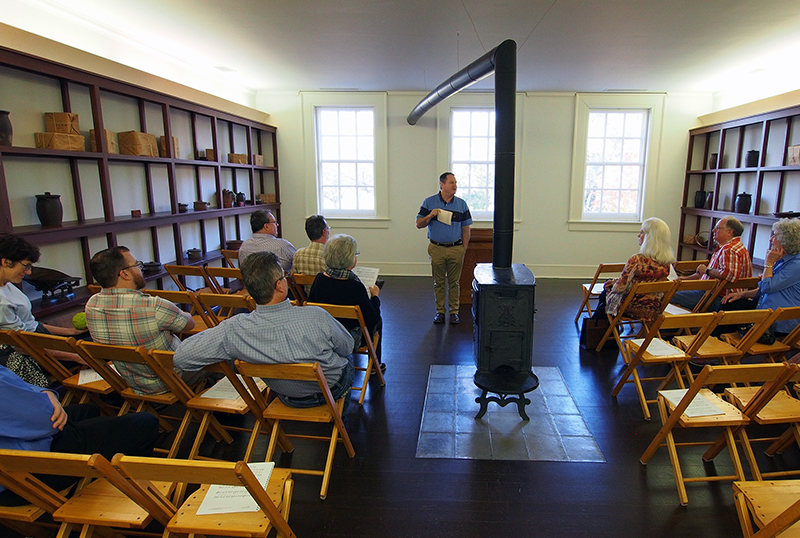
Community of Christ historian and guide Lachlan Mackay speaks to guests on the second floor of the Red Brick Store in Nauvoo, Ill., on Oct. 29, 2016. Photo by Dennis Piepergerdes
But the LDS church recognized Brigham Young as Smith’s successor. To them, the second floor is sacred because it is where Smith established temple “endowments” — a “gift of power from on high” that is the highest sacrament of the faith and can only be performed in temples.
Community of Christ does not have endowments, but it includes the historical information in tour materials and signage, and its tour guides are instructed in endowments’ importance for LDS visitors.
More problematic is an issue that roiled both denominations and kept them apart for at least a century. The Red Brick Store is where Smith recorded some teachings about plural marriage, which he secretly practiced as early as the 1840s and the LDS church practiced until 1890. The LDS church sanctified these teachings as scripture, Section 132 of the Doctrine and Covenants.
[ad number=“3”]
Community of Christ has always rejected plural marriage. For decades, many members insisted Smith never practiced it.
“Really, we were here to challenge the idea that Joseph Smith was a polygamist for much of our existence,” Mackay said from his office, a short walk from the Red Brick Store. “That is not what we are here to do to today. We are here to tell a powerful story of a people who believed life in a community is better than a life alone.”
What changed, Mackay said, was the Community of Christ’s attitude toward history. In the 1960s the Community began accepting what outside scholars were arguing about Smith — that he married about 30 women (but fathered children with only one of them, his first wife, Emma, according to modern DNA testing).
“Historians looked at our story; we embraced their work,” Mackay said. “It didn’t happen overnight and it was very painful. It came down to, if you had to choose between something Jesus said and something Joseph Smith said, what would you choose? And the answer for us, of course, was Jesus.”
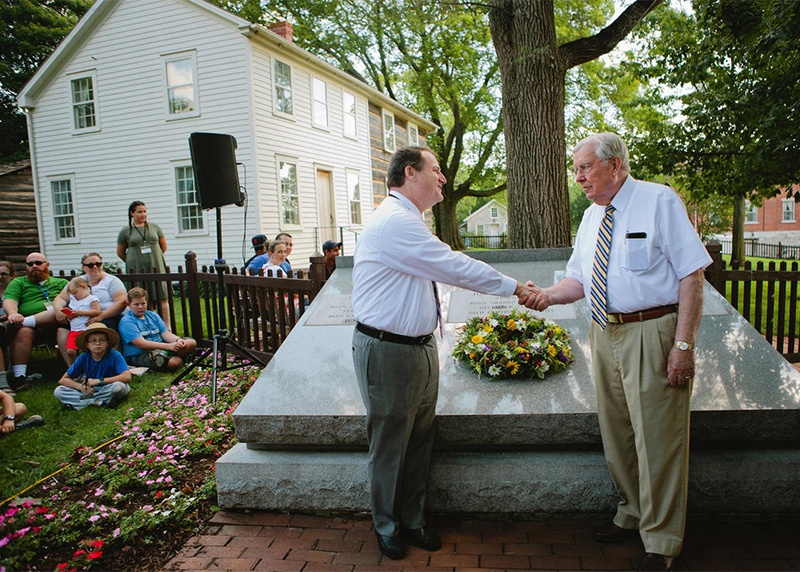
Lachlan Mackay, left, of the Community of Christ shakes hands with LDS Elder M. Russell Ballard during the Aug. 6, 2016, commemoration of the 25th anniversary of the dedication of the Smith Family Cemetery in Nauvoo, Ill. Both serve as members of the board of trustees for the Joseph Smith Sr. and Lucy Mack Smith Family Foundation. Photo by Lindsey Orton/Deseret News
Olsen, who often visits the LDS-owned Nauvoo sites, including the house where Brigham Young planned the Mormon exodus to the Salt Lake Basin, said the two groups realized that when they played their disagreements out in the Nauvoo sites, “the people who were victimized were the visitors.”
And “we got to know each other,” Olsen said. “Once we came together in academic and not sectarian forums we came to a mutual appreciation. We realized there is more that brings us together than drove us apart. There have been extraordinary things accomplished since we reached this detente.”
Last year, Mackay, a great-great-great-grandson of Joseph and Emma Smith, and M. Russell Ballard, an LDS elder and a great-great-grandson of Joseph Smith Jr.’s brother Hyrum, jointly laid a wreath at their ancestors’ graves near the Red Brick Store — something that wouldn’t have happened a generation ago.
“That symbolizes our relationship now,” Mackay said.
Temple Lot
Nowhere is this relationship played out more clearly than at the grassy field in Independence — about 275 miles west of Nauvoo — known as Temple Lot.
When Joseph Smith purchased Temple Lot in 1831, some Mormon elders dedicated the site to God.
“This spot is the center of the earth,” a resident recorded of the dedication in his journal. “This is the spot of ground on which the New Jerusalem is to be built.”
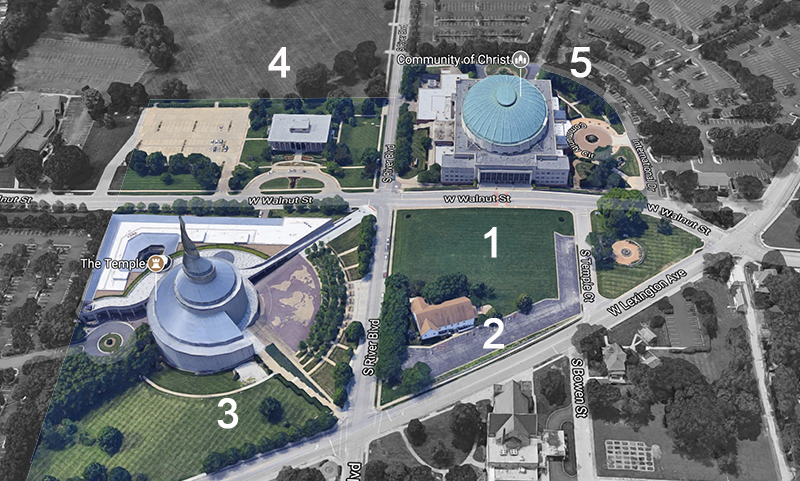
The contested space in Independence, Mo., centers on Temple Lot, 1, which is owned by Church of Christ (Temple Lot), 2. The Community of Christ Temple, 3, and Auditorium, 5, dominate the landscape. And Mormons coming to the LDS Independence Visitors’ Center, 4, make up the majority of tourists. Map courtesy of Google
But Mormons laid only the cornerstones — on view in the tiny museum in the Church of Christ (Temple Lot)’s building. Smith and his tens of thousands of followers fled the state in 1838 after its governor declared Mormons be “exterminated.”
After Smith’s death at the hands of an angry crowd in 1844, a breakaway Mormon sect called the Hedrickites came into possession of Temple Lot. The Community of Christ, then headed by Joseph Smith III, sued them for the deed.
The legal battle lasted from 1891 to 1896. In the end, the Hedrickites — by then renamed the Church of Christ (Temple Lot) — won. Both the Community of Christ and the LDS church made occasional offers to purchase it, but Church of Christ (Temple Lot) officials proclaimed they would never sell.
“It is not for sale at any price … to the LDS Church in Utah, nor to any other division of the Restoration,” church Apostle Clarence Wheaton said. “We hold (it) as a sacred trust before the Lord.”
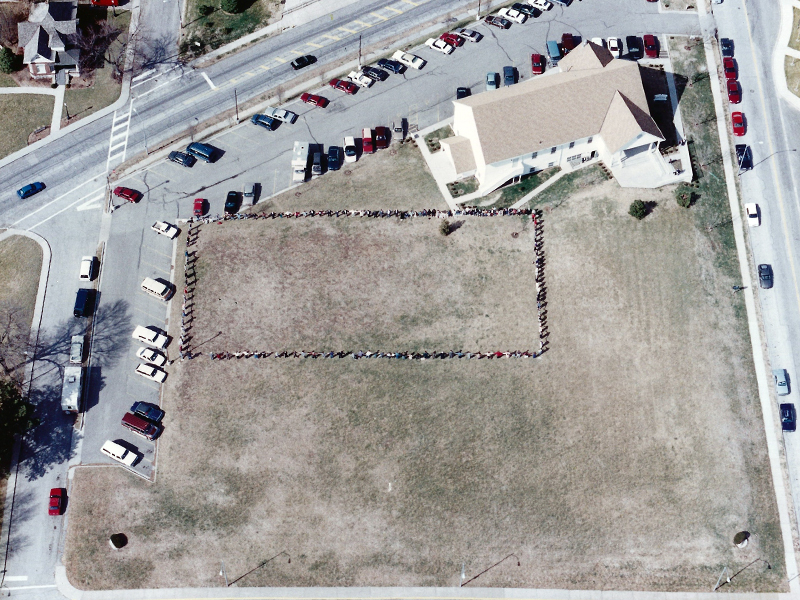
Members of Church of Christ (Temple Lot) stand on the boundaries of the proposed temple on the Temple Lot in Independence, Mo. Photo courtesy of Church of Christ (Temple Lot)
The land is still not for sale. Nor is it fenced in or guarded. On any summer day, busloads of LDS teens can be seen praying at the site, while Community of Christ members stroll over from a conference or service across the street.
Church of Christ still plans to build a temple on the site, but current efforts are hindered by money and local zoning laws.
There is speculation the LDS church would very much like to buy the lot. Olsen acknowledged the LDS church has the assets and likely the inclination to purchase the land, should it be for sale. In the meantime, the LDS church has given funds to Church of Christ for the land’s upkeep and restoration.
“It is a good relationship,” said Roland Sarratt, a Church of Christ (Temple Lot) leader and historian who presides over its tiny museum on Mondays. “They respect us even though our beliefs are quite different. It is like Christianity in general — we have a common belief in God and Jesus Christ and that belief keeps us from being at a sword’s point on various things.”
Sarratt, who is 82, remembers the old battles over the site — a “defense thing,” he called it. Now, he can walk across the Temple Lot, stand in the footsteps of Joseph Smith Jr. and see something else.
“I have hope, because the way the world is going, we don’t know what the Lord has in mind,” he said. “We don’t know how the temple will ever be built. But the Lord knows. That’s where we’re at.”
